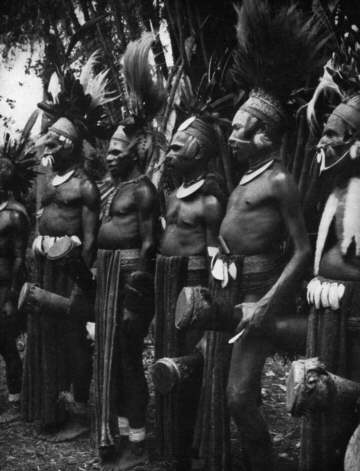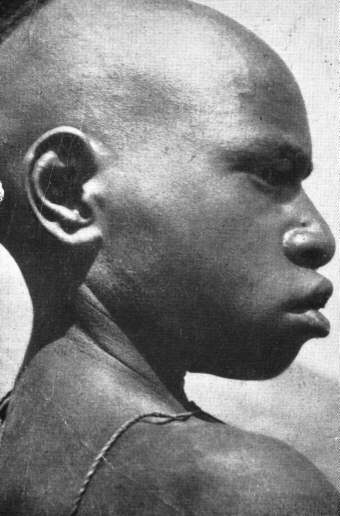
|
|
| Cannibal Culture | |
|
Selected excerpts from Jens Bjerre’s The Last Cannibals on primitive beliefs and customs New Guinea |
Cannibal Courtship and Customs (4)
Life among the Kumans is richer in songs, stories, feasts and ceremonies than among the Kukukukus. Their greatest feast, called Bogla Gende, occurs every five or six years, and as it is a feast for the whole tribe it attracts audiences of several hundreds. The preparations alone take almost a year. The two initial ceremonies are, first, selecting the pigs for the feast and, second, giving the pigs the first of many special feeds to fatten them up for slaughter. The men prepare the food and the women give it to the pigs, saying: ‘eat this quickly, get fat and heavy. We are already playing the flutes to celebrate your coming slaughter.’ New clearings are made so as to grow enough food for the feast. The men fell trees in the jungle to build three guest houses, often one hundred yards long, one for the men of the clan, one for the women and children, and one for guests from other clans.
As soon as the houses are ready and sufficient food gathered, the dancing starts: the big killing of pigs does not take place until the dances have lasted four weeks. The dances are marked by stamping and rhythmic swaying of the body to the accompaniment of songs and drums. Several of the men take turns in setting the pace and singing the ballads, which mainly describe everyday happenings. A man’s prestige depends very much on how he leads the singing and sometimes he even pays his friends to applaud him.

The dancing begins quietly enough; but after an hour the sweat pours off the dancers, the drums beat faster and faster, and the performers reach a condition of ecstasy. Various families take turns in dancing and keep it up for hours a day for five to seven weeks. The climax of this protracted affair comes when the pigs are slaughtered, and the orgy of eating lasts several days, after which everyone goes home, replete and exhausted. The sequel is often a prodigious hangover, due partly to the consequences of eating too much bad meat and partly also to the emotional exhaustion brought on by the prolonged excitements of the dancing. Family and tribal disputes are often traceable to these excesses.
The annual Harvest Festivals are quieter celebrations. A village gives part of its crop of sugar-cane, bananas or nuts to another village which, for this consideration, provides the festivities; the next year the roles are reversed. A third big feast, very similar to the Goanande ceremony is the one called Ambuingu Beglkua, which means: ‘the women break into the men’s house.’ This feast, which occurs every third or fourth year, begins with the young girls gathering, during the night, outside the house of the men of another clan. Singing the usual Goanande songs the girls, in couples, enter the hut where the men await them and sit down by the wall, each opposite a man. After a song session, like the one at a Goanande feast, the rest of the night is devoted to love-making. If a girl refuses to take part, she is sent home. During the day both the men and the girls dance outside the men’s hut to the accompaniment of drums, and from time to time couples break away and start a kango. These romps generally last four or five days and end with a substantial feast provided by the men.
The purpose of this ceremony, in which the usual rules of the clan are in abeyance, is no doubt to dispose of the unmarried girls. The Kumans have no use for old maids. Every mature woman is expected to have intercourse with a man; and a widow is disposed of to a fresh husband as soon as her period of mourning is over. The only bachelors in the clan are the feeble-minded or deficient. If a man becomes impotent he lends his wife to a clan brother in order to procure an addition to the family.

Kuman women, like most primitives, are dominated by their men; yet they are far from being defenceless, and have much more influence than one might expect. Their gossip about village problems and politics is often an important factor in determining the decisions of the clan. There are certain significant peculiarities about the relationship between the sexes. Ignorance of human physiology leads the Kumans to believe that women are dangerous to men during menstruation (although this does not apply between husband and wife) and a woman can use this supposition to revenge herself on a man who has angered her. She can step over his food, or brush it with her clothes, thus infecting it and causing illness in the man who is eating it. Anything a woman touches or steps across during this time is thereby considered unclean and dangerous: tools, building materials, food or firewood. A man seldom sits down where a woman has just been without first rubbing the spot with some leaves or a stick. A woman is also an offence to men when she is going through the menopause, and if at that period she is seen by a man washing herself in a brook, she must give him a pig for having inconvenienced him in this way. In earlier times she might even be killed for this unconscious offence. At parties the men and women always sit in separate groups. A woman badly treated by her husband has been known to hang or drown herself in revenge, thereby not only putting the man in jeopardy of evil spirits, but also requiring him to pay her family a substantial compensation.
Jens Bjerre, The Last Cannibals, Michael Joseph, 1956 pp. 135-138